Focused primarily on home security, this wireless system also supports smart lighting.

Michael Brown / IDG
Today’s Best Tech Deals
Picked by TechHive’s Editors
Top Deals On Great Products
Picked by Techconnect’s Editors
Wyze Home Monitoring Bundle
Show More
Wyze Labs has adopted the old razor-and-blades business model to enter the home security market: It’s giving away its Wyze Home Monitoring starter kit to consumers who commit to one year of its professional monitoring service. As is its wont, however, Wyze is severely undercutting the competition on price: $60 buys the hardware and a full year of monitoring.
At $60 per year, Wyze’s professional monitoring will dispatch law enforcement if the security system goes into an alarm state. Monitoring is outsourced to the third-party service provider Noonlight, and it costs about half what Ring charges for its Ring Alarm DIY home security system (that’s on top of the $250 Ring charges for its starter kit). Ring outsources its professional monitoring, too; as you’ll see, however, Ring’s offering is more robust overall.
Since Wyze’s service plan includes full support for just one home security camera, it’s conceivable that Wyze’s service could end up costing just as much as Ring’s plan. That’s because Ring includes an unlimited number of cameras—including its video doorbells and floodlight cams—in its plan. You can add more than one camera to the Wyze system, but you’ll need to pay for a Cam Plus subscription for the second and each subsequent camera to unlock all of those cameras’ features.
This review is part of TechHive’s coverage of the best smart home systems, where you’ll find reviews of the competition’s offerings, plus a buyer’s guide to the features you should consider when shopping for this type of product.
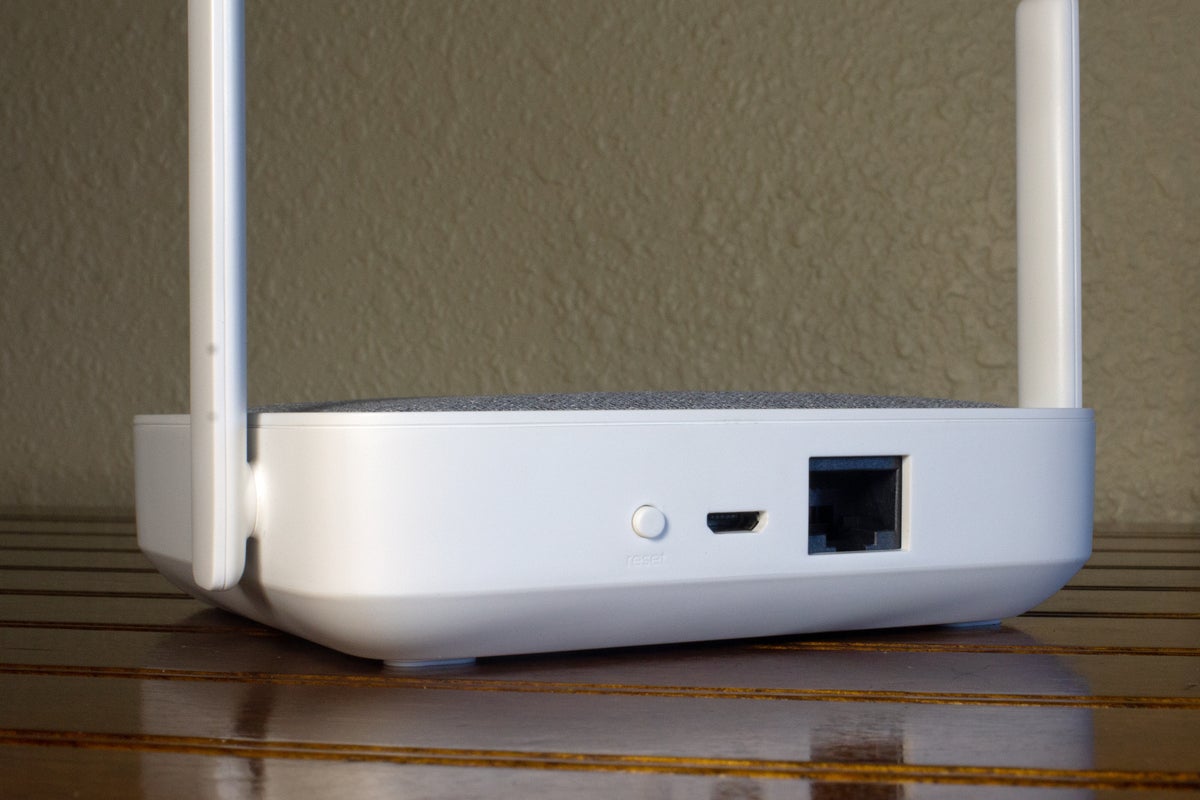 Michael Brown / IDG
Michael Brown / IDGThe Sense Hub is the heart of the Wyze Home Monitoring system and can connect to your network via Wi-Fi or ethernet cable.
Without a Cam Plus subscription, Wyze security cameras are limited to capturing just 12-second video clips, with a 5-minute cooldown between each recording, and you won’t get features such as person, package, and vehicle detection. You can see a comparison of the two service levels on Wyze’s website.
A Wyze Cam Plus subscription currently costs $14.99 per year ($1.25 per month) per camera, so in the unlikely event you decided to deploy eight more cameras, Wyze’s monitoring plan plus eight Cam Plus subscriptions would cost about the same as Ring’s service plan. Perhaps I should say in the impossible event you’ll want to deploy eight more Wyze cameras, because the system is currently limited to supporting five. That just one of several reasons why Ring’s system is more powerful. Lots of other features I asked Wyze about are on the Wyze Home Monitoring product roadmap—with some planned for deployment in 2021—but they’re not available in this first iteration of the system. I’ll go into more detail on that later.
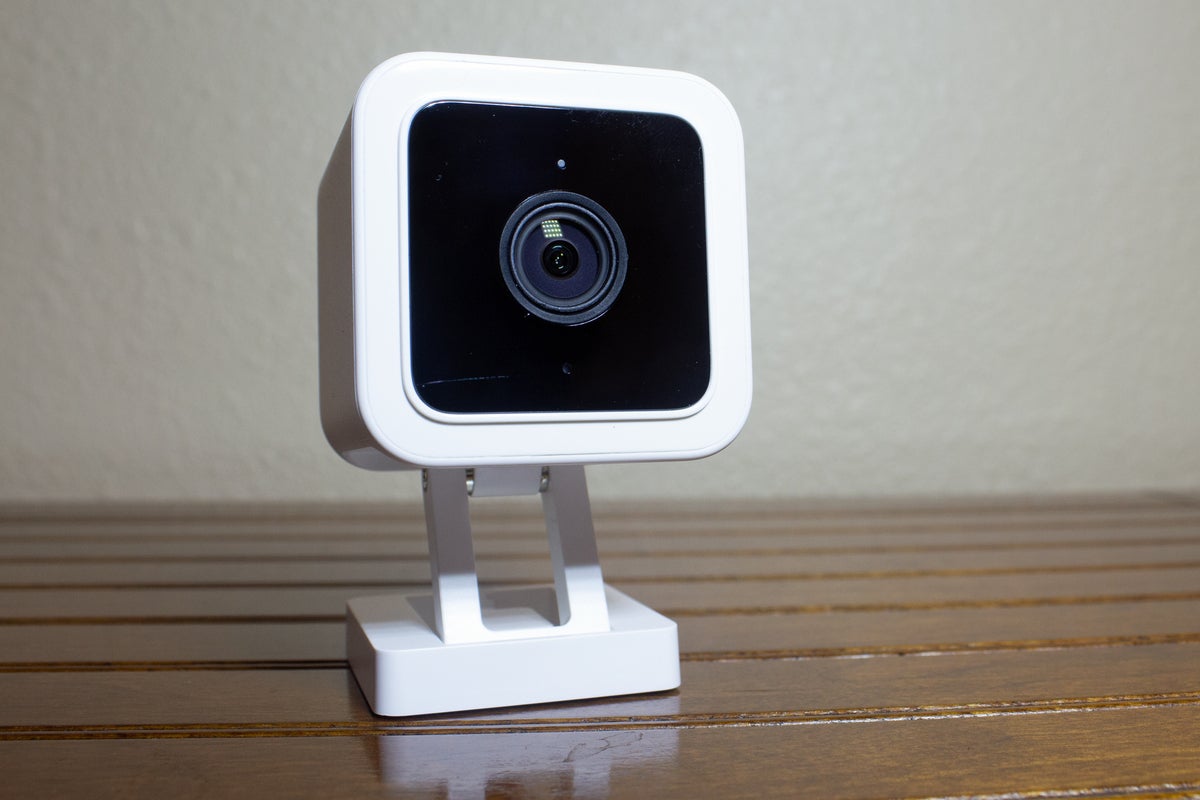 Michael Brown / IDG
Michael Brown / IDGThe Wyze Cam V2 is not included in the bundle, but it’s a great value for $24, and a Wyze Home Monitoring subscription includes Cam Plus service.
What’s in the starter bundle?
The Wyze Home Monitoring Bundle includes a base station—the Wyze Sense Hub—that connects to your home network (via Wi-Fi or ethernet cable); a 15-button, backlit keypad you’ll use to arm and disarm the system; two contact sensors you can attach to doors and/or windows; a motion sensor; and a couple of decals you can slap on your window to warn potential intruders that your home is protected by a security system. Advertising which home security system is protecting your home, however, is bad idea, because a well-educated intruder will know how to exploit any of its weaknesses (and the Wyze system has a significant weakness that I’ll get into later).
Wyze’s battery-powered motion sensors (AAA), contact sensors (AAA), and keypad (AA) communicate with the Sense Hub using unlicensed sub-GHz radio spectrum, which endows them with excellent range: Wyze specifies 500 feet indoors or 152 meters in an open field. In the real world, the contact and motion sensors triggered everywhere I tried them in my 2,800-square-foot home.
The keypad and motion sensor can be mounted to the wall using either the adhesive pads attached to them or with the provided screws (drywall anchors are also provided). The small-but-chunky keypad comes with a backplate that you can attach to the wall, so you can detach the keypad and carry it with you. You can deploy more than one keypad in case you want to install one at the front door and one at the back. The motion sensor gives you the option of corner mounting, which will enhance its coverage.
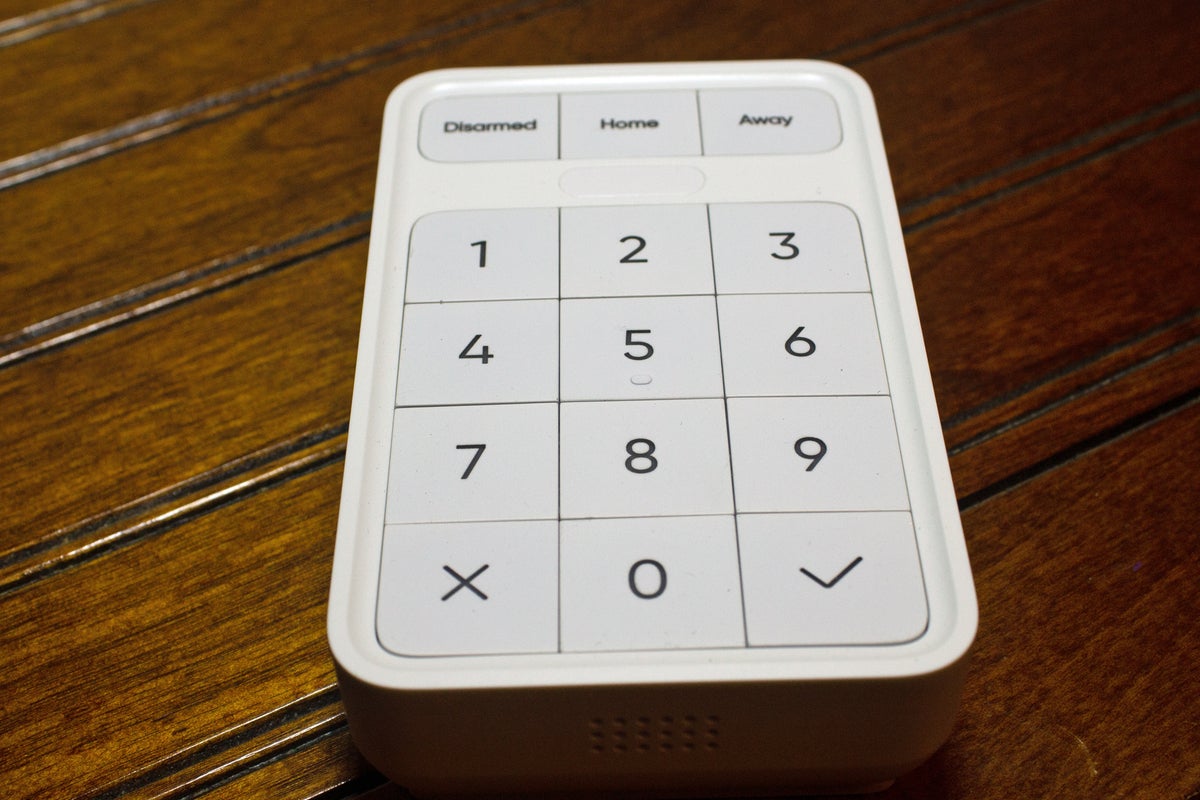 Michael Brown / IDG
Michael Brown / IDGYou can use either the Wyze Home Monitoring app or this wireless, battery-powered keypad to arm and disarm the security system.
The two-piece contact sensors can only be mounted using their adhesive pads. These sensors are relatively small and unobtrusive, though they’re not the smallest I’ve seen. Relying on adhesive always makes me nervous, because I’ve never seen a species that didn’t eventually lose its grip. And for installations on doors, I prefer the barrel type that fit inside the door and door frame, so they are completely hidden. But for the price, who’s to complain?
Contact sensors can be programmed to send a push notification when the door or window is opened, when it’s closed, when it’s been left open for a defined period of time, and when it’s been left closed for a defined period of time. Motion sensors send push notifications when they detect movement, and they can be programmed with three levels of sensitivity in case you find you’re furry friends are always setting them off.
Can Wyze Home Monitoring be expanded?
Since your home likely has more than room and more than one door and/or window you’ll want to monitor, you can expand the system with more sensors. The system supports up to 100, including a mixture contact sensors, motion sensors, and keypads. Contact sensors are sold in a three-pack for $19.99, motion sensors cost $7.99 each, and keypads are priced at $14.99 each (additional contact sensors and keypads are only available for pre-order at launch).
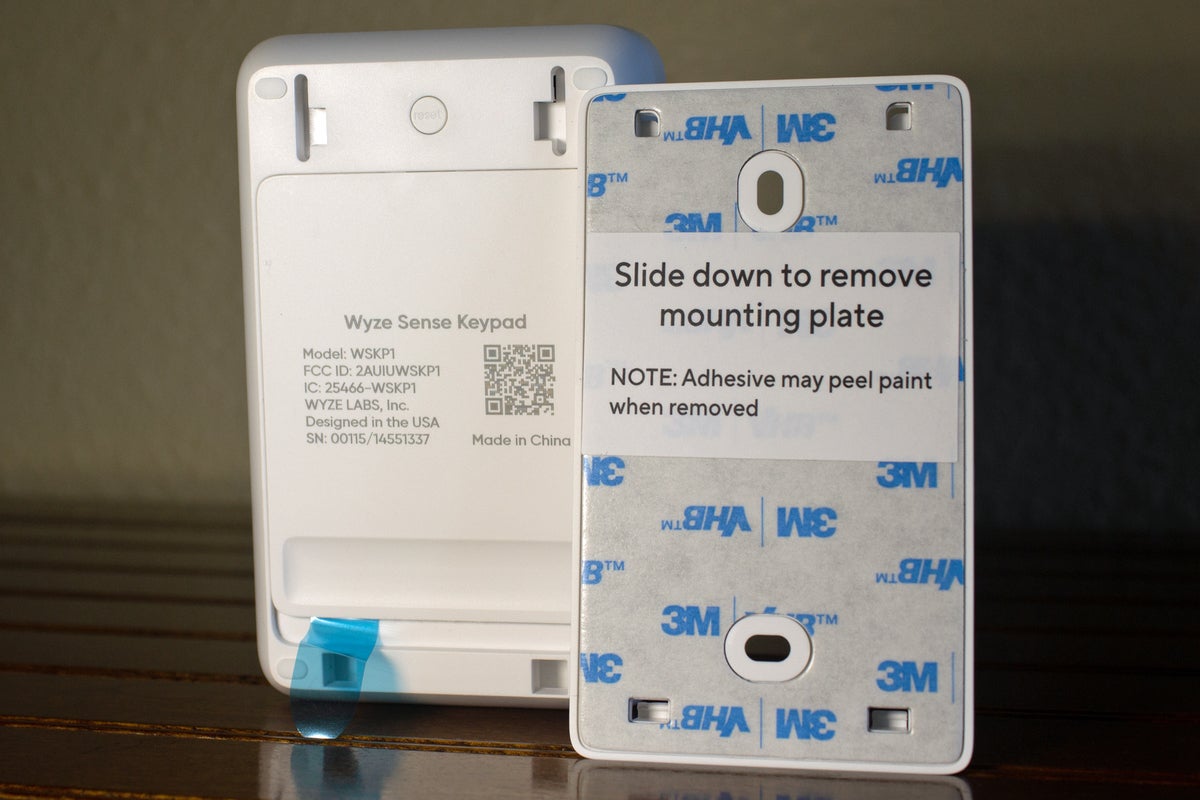 Michael Brown / IDG
Michael Brown / IDGThe keypad can be mounted to a backing plate that you attach to the wall, so you can detach it and take it with you.
You can further expand the system by adding Wyze’s Wi-Fi home security cameras (up to five for this release, though Wyze says it will increase that number down the road). The company sent its $24, indoor/outdoor Wyze Cam V3 in addition to the starter kit, so I could experience that integration. The camera connects to your 2.4GHz Wi-Fi network and from there to the Sense Hub. The other Wyze cameras you can link to the system are the Wyze Cam V2, the Wyze Cam Pan, and the Wyze Cam Outdoor. As I’ve already mentioned, a Home Monitoring license includes a Wyze Cam Plus subscription for one Wyze security camera; you’ll need to pay $14.99 per year for each additional Wyze cam to unlock all of each additional camera’s features.
The Wyze Home Monitoring system can also trigger Wyze smart lighting products (Wyze Bulb, Wyze Bulb Color, and its indoor and outdoor smart plugs). With these add-ons, you can trigger a light to illuminate your way when you enter a dark house, trigger all the lights to turn on when the system goes into an alarm state, and so on. There is currently no support for third-party smart lighting—or third-party anything, for that matter—and I don’t get the impression that will change any time soon.
What’s installation and setup like?
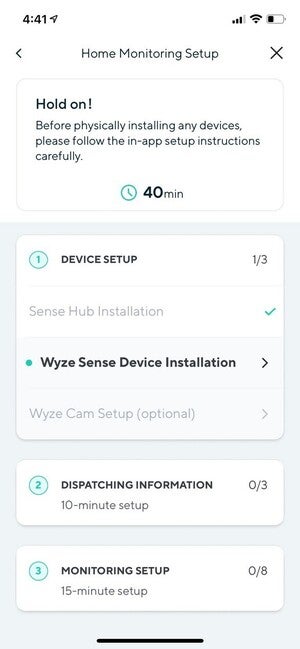 Michael Brown / IDG
Michael Brown / IDGWyze Labs’ app does an excellent job of letting you know what to expect during setup.
The Wyze Home Monitoring system is very easy to install and setup. A well-written and illustrated foldout user manual guides you through the process and offers tips on how to achieve the best performance, suggesting that you mount the motion sensor around 7 feet above the floor, for instance, and to avoid heat sources such as vents and lamps.
Wyze says you should be able to get the system up and running in 40 minutes or less, and I wouldn’t argue with that—it took me a little longer, but I was taking notes about my experience the whole time.
The installation process is typical for this type of device, though Wyze goes the extra mile in suggesting that you set up two-factor authentication when you install the Wyze app on your smartphone and create your monitoring account.
The options are SMS or an authenticator app, with the latter being more secure, so that’s what I did. The app suggests Microsoft Authenticator or Google Authenticator, but you can also search for another tool in your device’s app store. I elected for Google Authenticator since I’d already installed it on my iPhone. You’ll also designate a “safe word” that you can use to verify your identity when you interact with a representative of the Noonlight monitoring service. They’ll call you in an attempt to verify an emergency before dispatching the police. I should also point out here that some jurisdictions require that you take out a permit to deploy a home-security system that can contact first responders. Check yours before you order this system.
You’ll set up the Sense Hub next, plugging it into an outlet and connecting it to your network via Wi-Fi or an ethernet cable plugged into your router. You’ll then move on to configuring the battery-powered devices, including assigning them unique names, typically based on their location: Front Door, Back Door, Living Room, and so on. The app methodically steps you through this process, and as you pull the battery tabs to activate each device and pair it with the Sense Hub, a voice emanating from the hub will confirm success. When you set up the keypad, you’ll create a four-digit PIN that you’ll use to disarm the system. You can elect to require the PIN to change modes (Disarmed, Home, and Away) or—as is more convenient—only to disarm the system. You can also change modes and arm/disarm the system via the app.
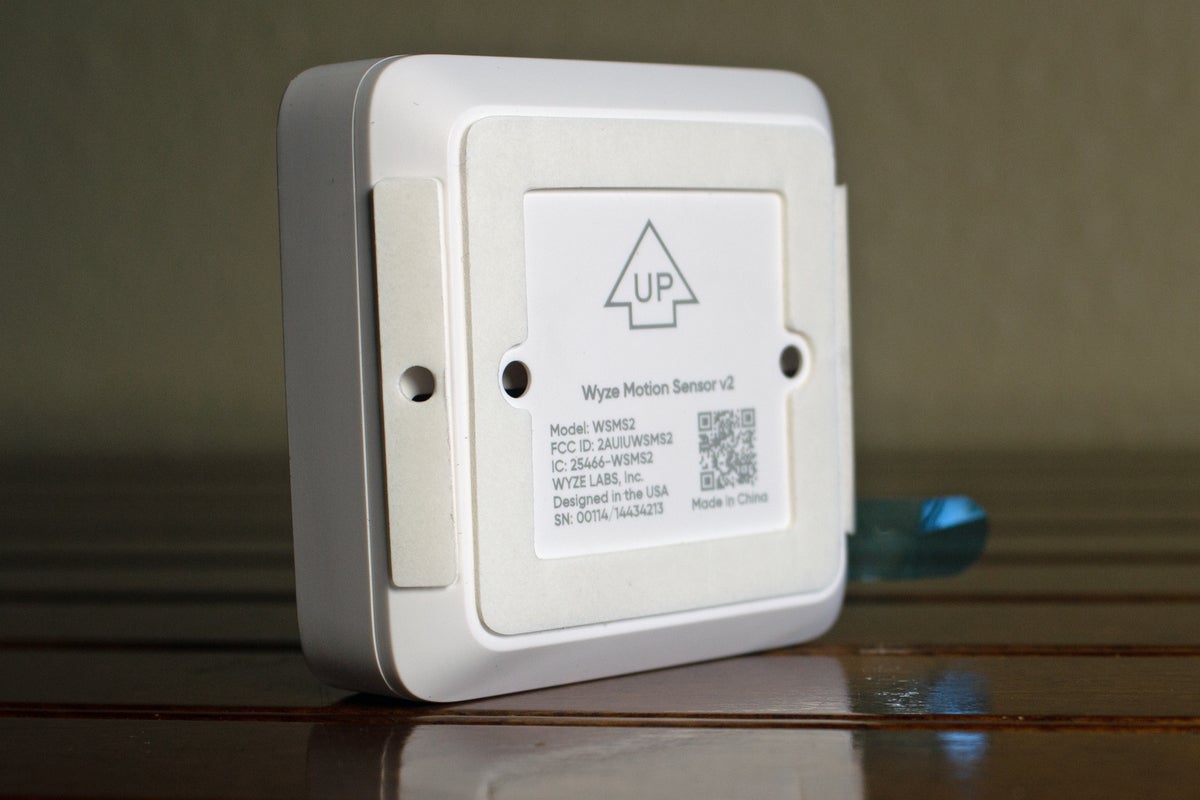 Michael Brown / IDG
Michael Brown / IDGThe motion sensor can be mounted on a flat surface or in a corner, using either the attached adhesive pads or screws.
The Sense Hub will sound a built-in siren for between 1 and 10 seconds (user choice) when the system goes into an alarm state, and it will sound a warning tone as it counts down to a mode change (Home or Away) or ahead of an alarm state (following any entry or exit delay you’ve programmed; more on that in a bit). The countdown tone and voice responses can be programmed with three volume levels—low, mid, and high—and the siren sounds louder than the 74db at 10 feet that Wyze specifies. That siren volume perception is a good thing, because you want to encourage an intruder to beat it.
You also have the option to have the Hub send a push notification or a critical alert to your phone when it goes into an alarm state. Critical alerts bypass your phone’s silent and do-not-disturb modes.
What’s it like to use Wyze Home Monitoring?
As is typical for a home security system, Wyze’s has three states—Disarmed, Home, and Away—which you can activate using dedicated buttons on the keypad or within the app. In its Disarmed state, nothing will trigger an alarm, but the camera will remain active, sending you push notifications according to whatever parameters you’ve established for it. Other sensors in the suite can also trigger the camera to record, so if you install the camera near your front door, you can have that contact sensor trigger the camera to record a clip of who’s entering or leaving.
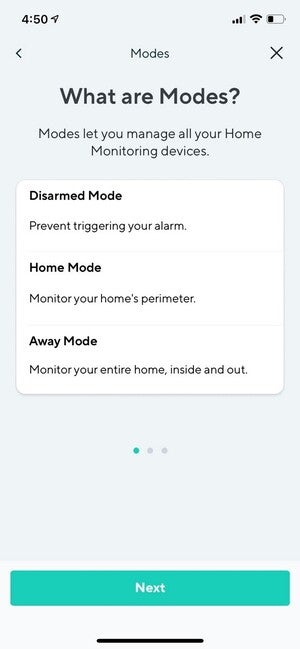 Michael Brown / IDG
Michael Brown / IDGThe Wyze Home Monitoring system is capable of the three usual home security modes: Disarmed, armed home, and armed away.
The motion sensor will also send push notifications unless you configure it otherwise. That got annoying quickly during my review, because I don’t need to know that someone is moving around inside my home when I’m there. On the other hand, you don’t want to disable the motion sensor’s push notifications altogether, because you do want to know if someone is moving around when you’re not there.
Fortunately, Wyze provides an easy solution: You can program rules that perform actions based on schedules, device triggers, or “shortcuts.” Shortcuts appear on the app’s home screen and execute when you tap them. I created an “I’m Home” shortcut that lets you turn off push notifications from the motion sensor. When I get home and disarm the system, I tap this button and it silences the motion sensor.
Each rule can have multiple actions, and you can arrange the actions in the order you want them performed. This is a really great feature.
With both the Home and Away modes, you have the option to set entry and exit delays that give you between 0 and 180 seconds to interact with the system before it goes into an alarm state. An entry delay gives you time to enter the house, reach the keypad, and enter your PIN to disarm the system before the siren goes off. An exit delay allows you to arm the system and get out of house before the system enters its armed state. Why would you want a zero-second delay in either case? If you use the app to disarm the system before you enter the house, and if you arm the system after you’ve left the house. A delayed state change in either of those scenarios is unnecessary and undesirable.
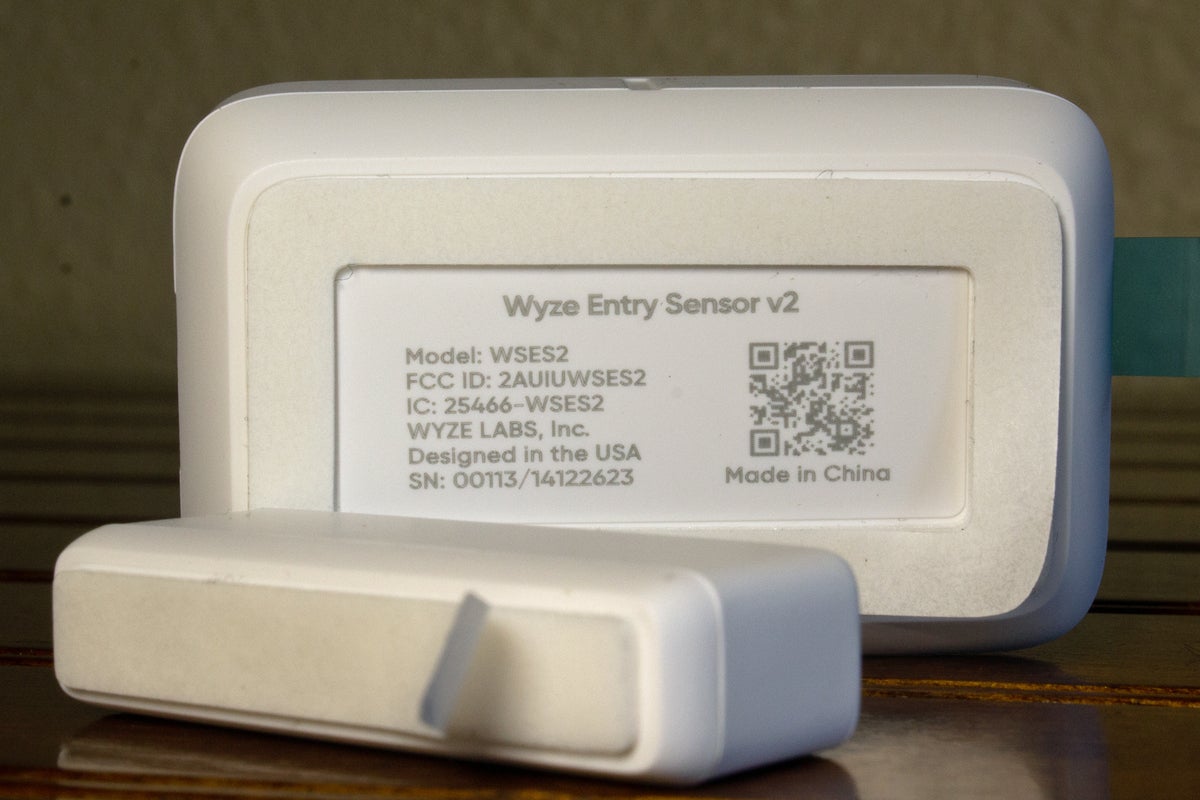 Michael Brown / IDG
Michael Brown / IDGPeel-and-stick adhesive pads are the only means of attaching Wyze Labs’ contact sensors to your doors and windows.
You can choose which sensors will trigger an alarm state, and your choices can be different for the Home and Away settings. But any selected contact sensor will initiate an entry delay before it puts the system in an armed state, whether it’s installed on a window or a door.
A better solution would be to allow you to distinguish between contact sensors installed on windows from the ones installed on doors, so that opening a door would trigger an entry delay if the system is armed Home, but opening a window would trigger an immediate alarm state. Why? Because you’ll use the Home setting most often when you go to bed, and while someone might need to come and go during that time, they’re not going to enter or exit through a window. The Wyze system also doesn’t allow you to bypass any sensors when you arm the system, which means you can’t leave that upstairs window open to ventilate the house while you’re away (unless you never put a contact sensor on it, that is).
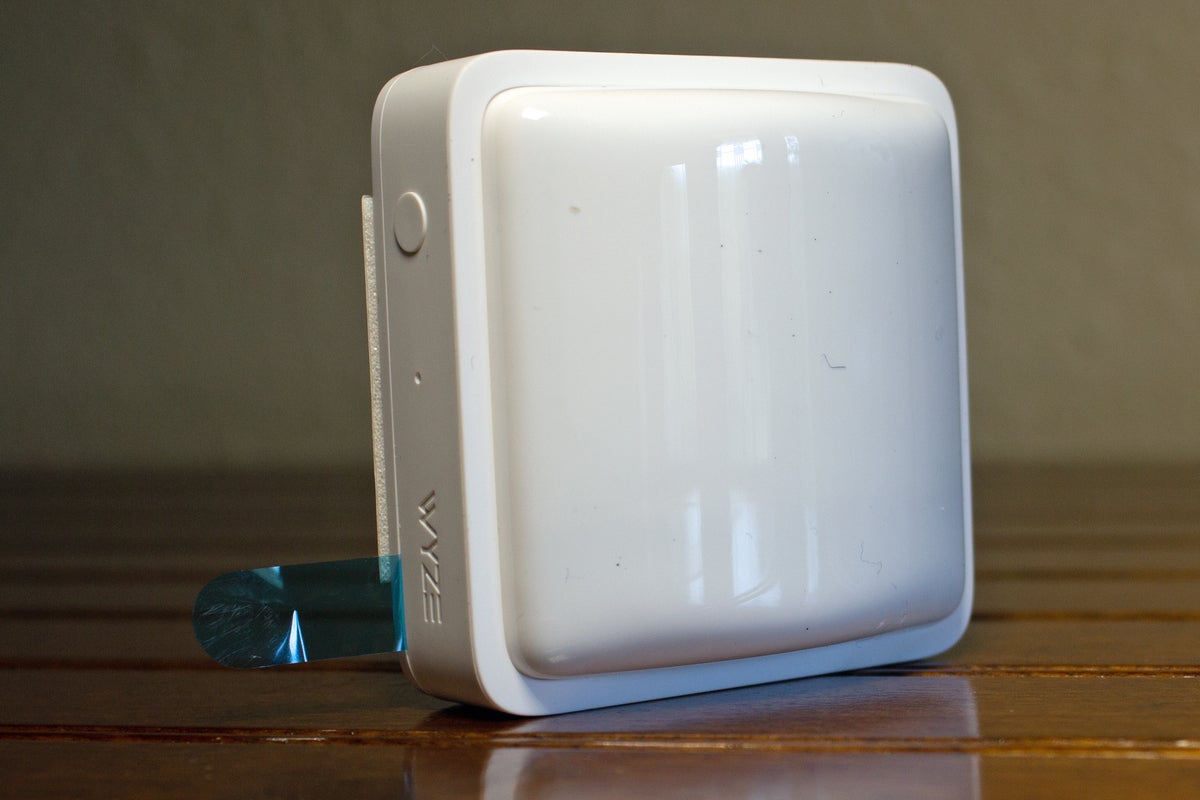 Michael Brown / IDG
Michael Brown / IDGThe compact Wyze Motion Sensor V2 performs well, and you can deploy additional units for just $7.99 each.
What are Wyze Home Monitoring’s weak spots?
From a security standpoint, the Wyze Home Monitoring system’s biggest weakness is that it lacks broadband failover. A smart thief will attempt to cut your home off from the internet by severing your broadband connection, whether that be a phone line for DSL service or a coax cable for cable-modem service. Without broadband service, the core of Wyze’s system—the Sense Hub—cannot send alerts to its professional monitoring service, and it can’t send push notifications directly to you. You might as well not have a security system at all.
Paying for professional monitoring on Ring’s service, in contrast, activates an LTE radio in the Ring Alarm hub that will provide a broadband connection should your primary service fail. The Sense Hub does have a battery backup that’s rated to last seven hours in the event of a power outage (and so does the Ring Alarm), but I would recommend connecting your smart home hub, your cable or DSL modem, and your router to an uninterruptible power supply anyway.
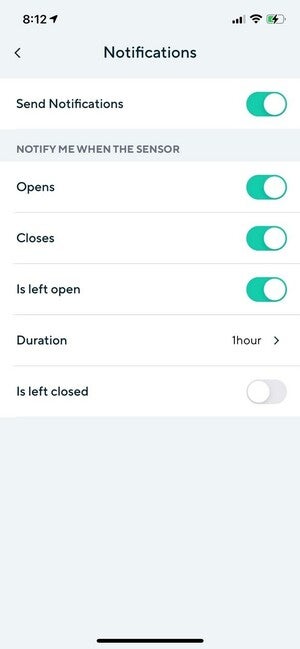 Michael Brown / IDG
Michael Brown / IDGYou can choose which sensors will trigger an alarm, but the system makes no distinction between contact sensors placed on doors and those placed on windows.
Wyze Labs offers a great video doorbell, smart entry lock, and exterior keypad for the price, but none of those home security devices can be tied into its Wyze Home Monitoring system today. Those capabilities are on the product roadmap, but who knows when that connectivity might be offered.
Wyze Labs’ security cameras will listen for the sound of a smoke or carbon-monoxide detector sounding off—even without a Cam Plus subscription—and they’ll send you a push notification if they hear that sound. But this isn’t tied into the Noonlight monitoring service, and your fire department won’t be dispatched if a smoke or CO detector does go off.
Wyze doesn’t offer a smoke or carbon-monoxide detector of its own today, though that’s another thing on its roadmap, and the system doesn’t support any third-party detectors. There is also no provision for dispatching first responders for medical emergencies.
Unlike the Ring Alarm system, the Wyze Sense Hub isn’t outfitted with Z-Wave or Zigbee radios, so it will never form the heart of a broader smart home system. And the company doesn’t seem interested in embracing third-party smart home products, so you’ll be in a walled garden when it comes to expanding your system or adding new features, such as the smoke and CO detectors I mentioned earlier.
There’s no support for geofencing that will automatically arm the system when you leave and disarm it when you return home, though here again, Wyze says it’s on the product roadmap. And finally, Wyze Home Monitoring is fully integrated with Amazon Alexa, but professional monitoring is not part of its Google Assistant support. Yes, that feature is on the roadmap, too. There are currently no plans, however, to support IFTTT (If This Then That)—which, it’s worth noting—is no longer a free consumer service unless you’re running three applets or less.
The bottom line on Wyze Home Monitoring
The Wyze Home Monitoring system is a robust home security system—for the price. Pay $60 for one year of home monitoring and you get all the equipment for free. The add-ons for expansion aren’t expensive either. If after a year you decide you don’t like or don’t need the service, the hardware will continue to operate and send you push notifications, so you can self-monitor your home’s security. I don’t think many people will ultimately go down that path, though, provided the cost of professional monitoring remains this low.
All that said, make sure you don’t mind living in Wyze Labs’ walled garden, and that you can accept this system’s weak spots—or hope the company addresses them soon. Other systems—Ring Alarm being the closest in price—deliver more, but they also cost more.
Note: When you purchase something after clicking links in our articles, we may earn a small commission. Read our affiliate link policy for more details.
Wyze Home Monitoring Bundle
There’s plenty of value packed into the Wyze Home Monitoring system, along with a few gotchas that will turn off smart home enthusiasts and hobble novices. Still, it’s a strong offering—if you can live with its limitations.
Pros
- Starter kit is essentially free
- Least-expensive professional monitoring on the market
- Also supports Wyze’s smart lighting products
Cons
- No provision for cellular failover
- You’ll be in a walled garden
- Professional monitoring covers law enforcement dispatch only
- Lots of desireable features still in development
Michael covers the smart-home, home-entertainment, and home-networking beats, working in the smart home he built in 2007.

